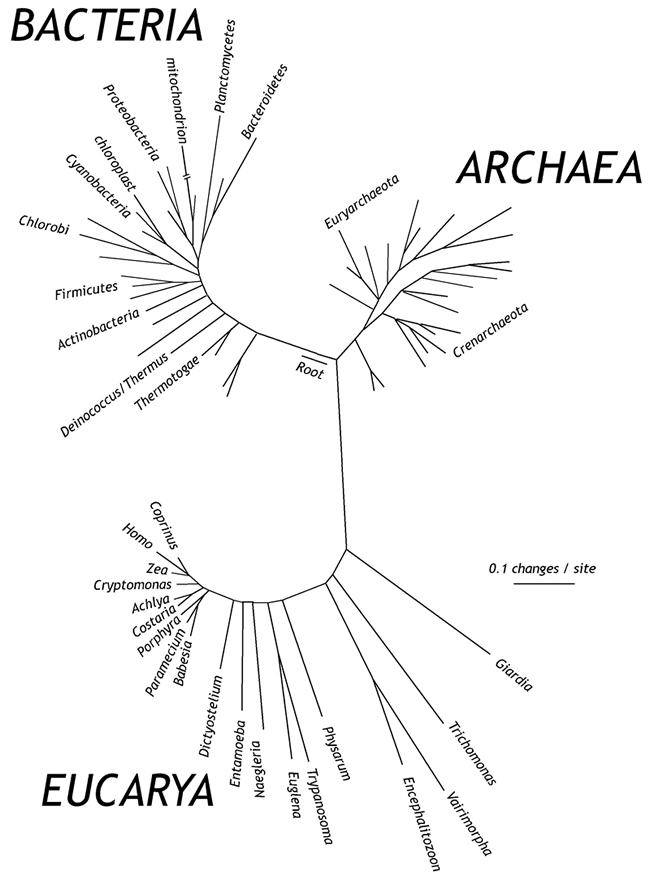Bacteria and Archaea

Electron micrograph of Pseudomonas with a single flagellum.
Bacteria and Archaea are the smallest independently living single-celled organisms on earth.
Typical cells range in size from 0.5 to1.0 µm in diameter. They all share a common structural feature – they lack a true membrane-bound nucleus. Instead, the DNA lies free in the cell cytoplasm. Their genome typically consists of a single circular molecule of double-stranded DNA, though many cells may also harbour a number of smaller DNA elements called plasmids. The genome size may vary depending on the lifestyle and complexity of the organism but ranges on average from 4 to 6 million nucleotides in length and codes for between 3000 and 4000 genes. A cell membrane comprised of phospholipids surrounds the cell. Outside this is the cell wall, which varies in composition depending on the organism, but is usually made up of protein and carbohydrate and lipids. Many microbes are motile by means of flagella (whip-like extensions from the cell) (Figure 1). They can also form fine filaments called pili that can attach the cells to each other or to surfaces such as the lining of our gut or rocks in streams. Some use special pili to attach to other microbes and transfer DNA in a process known as conjugation. This is as close as bacteria and archaea get to sexual reproduction. Most of the time they undergo asexual reproduction, mostly by dividing in half – some cells divide every 12–20 minutes, others take a lot longer.
All organisms require carbon, which provides building blocks for cell materials, and they also require a source of energy to drive the reactions involved in cell synthesis. Some Bacteria require oxygen for growth; others can grow without it (and oxygen may be toxic to the cell) and use alternative electron acceptors, including nitrate and sulphate.
Bacteria are widely distributed and you could almost say they’re everywhere. They reside in soil, water, food, on animal skins, and in animal guts. They are extremely metabolically diverse and can be divided into four major groups, based on their source of carbon and their source of energy:
- Photoautotrophs such as the cyanobacteria, grow by photosynthesis, obtaining their energy from sunlight, and carbon from fixation of carbon dioxide.
- Photoheterotrophs grow by photosynthesis if provided with an electron donor (hydrogen or an organic compound) for reductive assimilation of carbon dioxide. This group often requires selected growth factors such as B vitamins, and many will grow on organic substrates if oxygen is provided.
- Chemoautotrophs use reduced inorganic substrates for both the reductive assimilation of carbon dioxide (carbon fixation) and as a source of energy. The major energy sources for these organisms are hydrogen, ammonia, nitrite, hydrogen sulphide and the ferrous ion (Fe2+).
- Chemoheterotrophs require preformed organic molecules as their sources of both carbon and energy. Some Bacteria use simple carbon sources such as glucose or succinate, whereas others degrade more complex substrates such as proteins and carbohydrates. Although some Bacteria such as Pseudomonas may utilise up to 100 different carbon sources for growth, most are capable of growth on a more limited number. The vast majority of Bacteria that have been described are chemoheterotrophs.
Archaea were originally thought to exist only in harsh environments and were often described as 'extremophiles', but we now know that they are widely distributed and are found alongside bacteria in many environments including soil and water. The best described groups of Archaea are the methanogens that produce methane, and the extremophiles that grow under high salt or extreme temperatures. Pyrodictum, for example, has an optimal growth temperature of 105°C.
It is difficult to distinguish Archaea and Bacteria on the basis of their morphology. However, with the advent of molecular phylogenetic analysis we now know that these two kingdoms are as different from each other as they are from Eucarya. Bacteria and Archaea are classified into phyla using phylogenetic information from analysis of genetic sequences of ribosomal RNA. Bacteria have been subdivided into >100 phyla, whereas Archaea have been grouped into two (with a further two proposed). A phylogenetic tree showing the three domains of organisms – Bacteria, Archaea and Eucarya – based on a comparison of 16S ribosomal rRNA sequences is given in Figure 2.
 |
| Figure 2. Tree of life showing the three domains of life (Bacteria, Archaea, Eucarya) based on sequencing of 16S ribosomal RNA (modified from NR Pace). |
